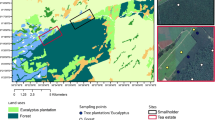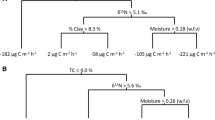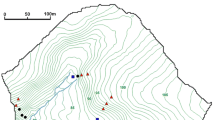ABSTRACT
Tropical soils account for 10%–20% of the 15–35 Tg of atmospheric methane (CH4) consumed annually by soils, although tropical deforestation could be changing the soil sink. The objectives of this study were (a) to quantify differences in soil CH4 fluxes among primary forest, secondary forest, active pasture, and degraded pasture in eastern Amazonia; and (b) to investigate controlling mechanisms of CH4 fluxes, including N availability, gas-phase transport, and soil respiration. At one ranch, Fazenda Vitória, annual uptake estimates (kg CH4ha−1 y−1) based on monthly measurements were: primary forest, 2.1; secondary forest, 1.0; active pasture, 1.3; degraded pasture, 3.1. The lower annual uptake in the active pasture compared with the primary forest was due to CH4 production during the wet season in the pasture soils, which is consistent with findings from other studies. In contrast, the degraded pasture was never a CH4 source. Expressing uptake as a negative flux and emission as a positive flux, CH4 fluxes were positively correlated with CO2 fluxes, indicating that root and microbial respiration in the productive pastures, and to a lesser extent in the primary forest, contributed to the formation of anaerobic microsites where CH4 was produced, whereas this productivity was absent in the degraded pasture. In all land uses, uptake rates of atmospheric CH4 were greater in the dry season than in the wet season, indicating the importance of soil water content and gas transport on CH4 fluxes. These clay soils had low annual uptake rates relative to reported rates on sandy soils, which also is consistent with gas transport within the soil being a limiting factor. Nitrogen availability indices did not correlate with CH4 fluxes, indicating that inhibition of CH4 oxidation was not an important mechanism explaining differences among land uses. At another ranch, Fazenda Agua Parada, no significant effect of pasture age was observed along a chronosequence of pasture ages. We conclude that land-use change can either increase or decrease the soil sink of CH4, depending on the duration of wet and dry seasons, the effects of seasonal precipitation on gas-phase transport, and the phenology and relative productivity of the vegetation in each land use.
Similar content being viewed by others
Author information
Authors and Affiliations
Rights and permissions
About this article
Cite this article
Verchot, L., Davidson, E., Cattânio, J. et al. Land-Use Change and Biogeochemical Controls of Methane Fluxes in Soils of Eastern Amazonia. Ecosystems 3, 41–56 (2000). https://doi.org/10.1007/s100210000009
Issue Date:
DOI: https://doi.org/10.1007/s100210000009




